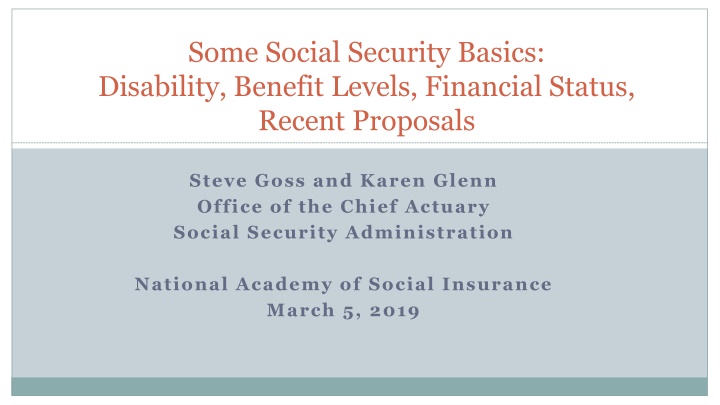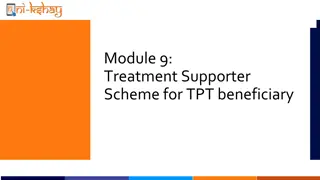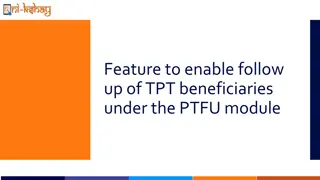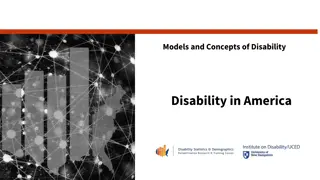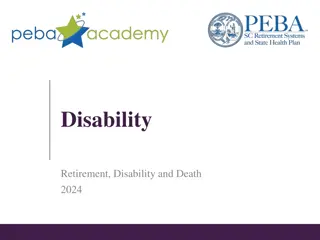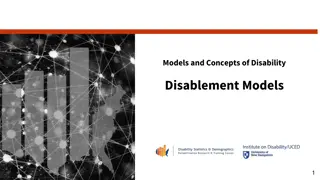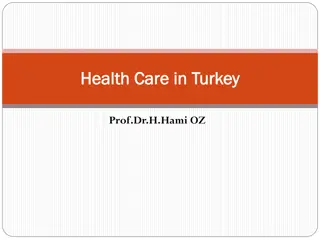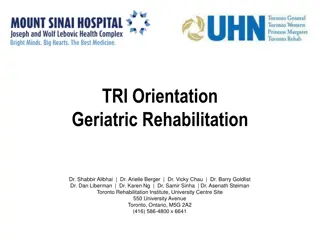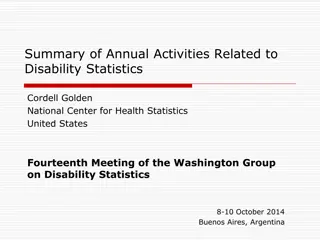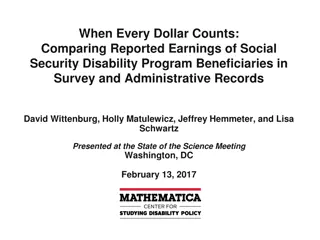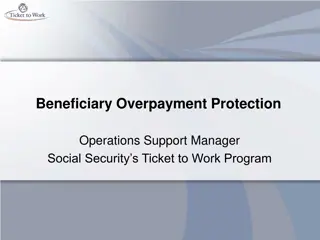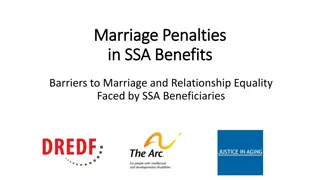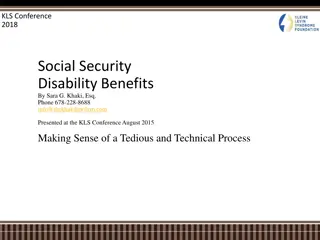Social Security Disability Benefits Overview: Basics, Beneficiaries, Trends
Social Security Disability Benefits cover millions of workers, with details on eligibility, monitoring, and recent trends in applications and incidence rates. Explore the factors influencing the future of disability benefits.
Download Presentation

Please find below an Image/Link to download the presentation.
The content on the website is provided AS IS for your information and personal use only. It may not be sold, licensed, or shared on other websites without obtaining consent from the author.If you encounter any issues during the download, it is possible that the publisher has removed the file from their server.
You are allowed to download the files provided on this website for personal or commercial use, subject to the condition that they are used lawfully. All files are the property of their respective owners.
The content on the website is provided AS IS for your information and personal use only. It may not be sold, licensed, or shared on other websites without obtaining consent from the author.
E N D
Presentation Transcript
Some Social Security Basics: Disability, Benefit Levels, Financial Status, Recent Proposals Steve Goss and Karen Glenn Office of the Chief Actuary Social Security Administration National Academy of Social Insurance March 5, 2019
Social Security Disability Benefits 155 million workers under age 66 are insured against becoming unable to work 8.7 million workers now receive DI benefits 1.7 million dependents mostly children Many more protected from loss of insured status And from lower retirement benefits In addition: 1 million disabled adult child beneficiaries 0.3 million disabled widow(er) beneficiaries OCACT/SSA 2
Social Security Disability Benefits Requires inability to engage in any substantial gainful activity (SGA) due to medically determinable impairment May be determined disabled if have severe impairments, meeting or equaling specific medical listings Or if, in addition to a severe impairment, there are substantial functional limitations considering age, education, and past work Beneficiaries are monitored for medical improvement by diaries with periodic Continuing Medical Reviews Beneficiaries are encouraged to return to work which can cease benefits OCACT/SSA 3
Recent Favorable Disability Experience Applications and incidence are at historic low levels Numbers of beneficiaries have been declining since 2013 Prevalence rates have peaked and are dropping What about the future? Are declines temporary, or the new state? Possibilities: Economy and jobs temporary Drop in hearings allowance rates temporary? Increased health care (ACA) Field office consolidations Attorney representation Something more fundamental? OCACT/SSA 4
Applications Are Still Dropping in 2018! OCACT/SSA 5
Disability Incidence Rate Falls to Historic Lows DI disabled worker incidence rate rose sharply in the recession, and has declined since the peak in 2010 to extraordinarily low levels for 2016 through 2018 DI Age-Sex-Adjusted Incidence Rates: Historical and Intermediate Assumptions for 2012 through 2018 Trustees Reports 6.5 Average 1990-2017 5.23 Ultimate Assumption 5.40 2012TR 6 2013TR 5.5 2014TR 5 2015TR 4.5 2016TR 2018TR 2017TR 4 1990 1995 2000 2005 2010 2015 2020 2025 2030 6 OCACT/SSA
Fewer Disabled Worker Beneficiaries Fewer now and in near term based on recent applications and incidence rates Disabled Worker Beneficiaries In Current Payment Status at End of Year (in thousands) 11,000 10,000 2017 TR 9,000 2018 TR 8,000 2008 TR (no recession) 7,000 6,000 2006 2007 2008 2009 2010 2011 2012 2013 2014 2015 2016 2017 2018 2019 2020 2021 2022 2023 2024 2025 2026 2027 OCACT/SSA 7
DIBs awarded through June 2018 by year of entitlement and primary diagnosis code, males age 30-39 at entitlement 100% 90% 80% 70% Entitlements (Percent of annual total) 60% 50% 40% 30% 20% 10% 0% 1982 1984 1986 1988 1990 1992 1994 1996 1998 2000 2002 2004 2006 2008 2010 2012 2014 2016 Year of entitlement Musculoskeletal Nervous System Infectious/parasitic Mental disorders Injuries Other Circulatory Respiratory Neoplasms Nutritional/metabolic 8 OCACT/SSA
DIBs awarded through June 2018 by year of entitlement and primary diagnosis code, males age 50-59 at entitlement 100% 90% 80% 70% Entitlements (Percent of annual total) 60% 50% 40% 30% 20% 10% 0% 1982 1984 1986 1988 1990 1992 1994 1996 1998 2000 2002 2004 2006 2008 2010 2012 2014 2016 Year of entitlement Musculoskeletal Nervous System Infectious/parasitic Mental disorders Injuries Other Circulatory Respiratory Neoplasms Nutritional/metabolic 9 OCACT/SSA
Social Security Monthly Benefit Levels Primary Insurance Amount (PIA) is a progressive formula replacing a portion of worker s career-average past earnings level (highest 35 years of earnings indexed to average wage for retirees) Benefits replace 40% to 45% of career earnings, on average About 80% for very-low earner, about 28% for steady maximum earner Auxiliary beneficiaries (family members) may receive half of the PIA of the retired or disabled worker Surviving spouses may receive 100 percent; other survivors 75 percent Total benefits payable on a worker s account limited to family max Retired-worker and spouse benefits are modified by age at start of receipt OCACT/SSA 10
Replacement Rates Based on the 2018 TR Scheduled Monthly Benefit Levels as Percent of Career-Average Earnings by Year of Retirement at age 65 70 60 Low Earner ($23,353 for 2018; 25th percentile) 50 40 Medium Earner ($51,894 for 2018; 56th percentile) High Earner ($83,031 for 2018; 82nd percentile) 30 Max Earner ($128,400 for 2018; 100th percentile) 20 10 0 1940 1960 1980 2000 2020 2040 2060 2080 Source: Annual Recurring Actuarial Note #9 at www.ssa.gov/oact/NOTES/ran9/index.html OCACT/SSA 11
How About at Age 62, Where Many Start Benefits? Scheduled Monthly Benefit Levels as Percent of Career-Average Earnings by Year of Retirement at age 62 70 60 50 Low Earner ($23,353 in 2018; 25th percentile) 40 Medium Earner ($51,894 in 2018; 56th percentile) 30 High Earner ($83,031 in 2018; 82nd percentile) Max Earner ($128,400 in 2018; 100th percentile) 20 10 0 1960 1980 2000 2020 2040 2060 2080 Source: Annual Recurring Actuarial Note #9 at www.ssa.gov/oact/NOTES/ran9/index.html 12 OCACT/SSA
Payable Benefits Under the Law, After Trust Fund Reserves Are Depleted, Are Even Lower PAYABLE Monthly Benefit Levels as Percent of Career-Average Earnings by Year of Retirement at age 62 70 60 50 40 Low Earner ($23,353 in 2018; 25th percentile) 30 Medium Earner ($51,894 in 2018; 56th percentile) High Earner ($83,031 in 2018; 82nd percentile) 20 Max Earner ($128,400 in 2018; 100th percentile) 10 0 1960 1980 2000 2020 2040 2060 2080 Source: Annual Recurring Actuarial Note #9 at www.ssa.gov/oact/NOTES/ran9/index.html 13 OCACT/SSA
Social Security Monthly Benefit Levels Monthly benefit level after initial eligibility increases with COLA Based on CPI-W (urban wage earners) Thus, while individuals benefits keep up with price levels, they fall behind average earnings levels Benefit levels from one generation to the next rise with average earnings But the special minimum benefit has been only CPI-indexed So now applies to virtually no beneficiaries Monthly benefit levels may be offset by WEP, GPO, and workers comp Disability benefits may be suspended or ceased due to earnings Other benefits (under the Normal Retirement Age) may be deferred by earnings test OCACT/SSA 14
SOLVENCY: OASDI Trust Fund Reserve Depletion in 2034 Reserve depletion date varied from 2029 to 2042 in reports over the past 26 years (1992-2018) Social Security Trust Fund Ratios Assets as Percent of Annual Cost Trustees Report Intermediate Projections 450% Historical OASDI 2018TR OASI 2018TR DI 2018TR OASDI 2017TR OASI 2017TR DI 2017TR 400% 350% 300% 250% OASI 200% OASDI 150% 100% DI 50% Tax Rate Reallocation 0% 1990 1995 2000 2005 2010 2015 2020 2025 2030 2035 2040 OCACT/SSA 15
Changing Age Distribution Over Last 20 and Next 20 Years Largely Explain the Financial Status of the OASI and DI Trust Funds Age Distribution of the Population Age 25+, 1940 to 2100 (2018 TR) 100% 85+ Boomers become 65-84 90% 65-84 80% Percent of Population at Ages 25+ 70% Boomers become 45-64 60% 45-64 50% 40% Boomers become 25-44 30% 25-44 20% 10% 0% 1940 1950 1960 1970 1980 1990 2000 2010 2020 2030 2040 2050 2060 2070 2080 2090 2100 16 OCACT/SSA
OASDI Annual Cost and Non-Interest Income as Percent of Taxable Payroll Persistent Negative Annual Cash-Flow Balance Starting in 2010 79% of scheduled benefits still payable at trust fund reserve depletion Annual deficit in 2092: 4.32 percent of payroll 25% Cost: Scheduled but not fully payable benefits Cost: Scheduled and payable benefits 20% 15% Non-interest Income 10% Expenditures: Payable benefits = income after trust fund depletion in 2034 Payable benefits as percent of scheduled benefits: 2017-33: 100% 2034: 79% 2092: 74% 5% 0% 2005 2015 2025 2035 2045 2055 2065 2075 2085 2095 Calendar year 17 OCACT/SSA
SUSTAINABILITY: Cost as Percent of GDP Rises from a 4.2-percent average in 1990-2008, to about 6.1% by 2038, then declines to 5.9% by 2052, and generally increases to 6.1% by 2092 10% Historical Estimated 8% Cost 6% Non-interest Income 4% 2% 0% 1990 2000 2010 2020 2030 2040 Calendar year 2050 2060 2070 2080 2090 18 OCACT/SSA
The Bottom Line Long-term projections provide information to assess solvency and changes needed to eliminate shortfalls If trust fund reserves were to deplete: Full benefits cannot be paid on time no borrowing authority So Congress must act, as it always has Straightforward solutions: Add revenue and/or lower cost for OASDI Comprehensive changes implemented by 2034 19 OCACT/SSA
How to Fix Social Security Long-Term Make choices addressing OASDI deficits 2034-2092: Raise scheduled revenue after 2033 by about one-third Reduce scheduled benefits after 2033 by about one-fourth Or some combination of the two Invest trust funds for higher return? Limited help it is a PAYGO world So invest in coming generations of workers 20 OCACT/SSA
Ways to Lower Cost Lower benefits for retirees not disabled? Increase normal retirement age (lowers OASDI cost, but increases DI cost) Can exempt long-career low earners Lower benefits mainly for high earners? Reduce PIA above some level Often combined with increasing PIA below some level, subject to work year requirements Lower benefits mainly for the oldest old? Reduce the COLA: chained CPI? But, some say increase it with the CPI-E (based on purchases of consumers over age 62) 21 OCACT/SSA
Ways to Increase Revenue Raise the 12.4 percent OASDI payroll tax rate? Raise tax on highest earners? Increase taxable maximum amount Some tax on all earnings above the maximum Tax employer group health insurance premiums? Affects only middle class if taxable maximum remains Tax investment income? 22 OCACT/SSA
Examples of Comprehensive Proposals Larson, Blumenthal, Van Hollen introduced in January 2019 Increase revenue to cover shortfall, and increase some benefits Johnson introduced in December 2016 Largely reduce scheduled benefits, but eliminate taxation of benefits and add minimum benefits Simpson-Bowles Commission plan released in December 2010, but not introduced A mix of additional revenue and reduced benefits 23 OCACT/SSA
Representative John Larson (D-CT) et al, January 2019 Make PIA formula slightly more generous, more progressive (shortfall 8%) Increase the COLA ( 14%) Based on CPI-E for all beneficiaries; 0.2pp higher on average Index designed to better reflect the purchases of the elderly Improve the minimum benefit ( 4%) Lower taxation of OASDI benefits slightly ( 6%) Tax earnings above $400K (not indexed) with small benefit credit ( 67%) Increase payroll tax rate gradually from 12.4 percent to 14.8 percent ( 64%) Would produce sustainable solvency (shortfall 109%) See: https://www.ssa.gov/OACT/solvency/LarsonBlumenthalVanHollen_20190130.pdf 24 OCACT/SSA
Representative Sam Johnson (R-TX), December 2016 Make PIA formula less generous but more progressive (shortfall 32%) Change to mini-PIA approach ( 13%) Raise the Normal Retirement Age gradually ( 32%) Lower the COLA ( 47%) Based on chain-weighted CPI for most beneficiaries; 0.3pp lower on average No COLA if prior year s MAGI is above certain thresholds Add a new minimum benefit ( 9%) Eliminate taxation of OASDI benefits in 2054 and later ( 15%) Would produce sustainable solvency (shortfall 100%) See: https://www.ssa.gov/OACT/solvency/SJohnson_20161208.pdf 25 OCACT/SSA
Simpson-Bowles Commission, December 2010 Index NRA to keep ratio of retirement years to work years constant, with exemption for long-career low earners (shortfall 18%) Make PIA formula less generous but more progressive (shortfall 45%) Lower the COLA ( 26%) Based on chain-weighted CPI; 0.3pp lower on average Improve the minimum benefit ( 8%) Increase benefits 5 percent for older retirees ( 8%) Increase taxable maximum to cover 90 percent of earnings ( 35%) Cover newly hired state and local gov t employees ( 8%) Would produce sustainable solvency (shortfall 112%) See: https://www.ssa.gov/OACT/solvency/FiscalCommission_20101201.pdf 26 OCACT/SSA
